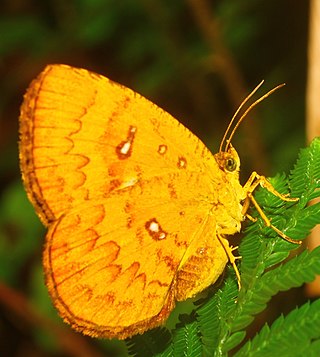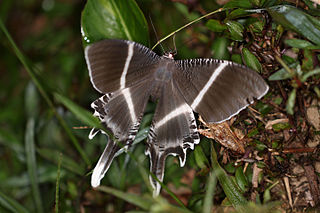
Callidulidae, the only known family of the superfamily Calliduloidea, is the family of Old World butterfly-moths, containing eight genera. They have a peculiar distribution, restricted to the Old World tropics of Southeast Asia to Australasia and Madagascar. The three subfamilies exhibit both day- and night-flying behaviour.
Whalleyana is an enigmatic genus of moths in the lepidopteran group Obtectomera, endemic to Madagascar. The genus contains two species, whose biology are unknown. The genus had been placed in the picture-winged leaf moths, (Thyrididae), but then was placed in its own family, and later elevated to its own superfamily ; see also Fänger (2004). The genus was named after Paul E. S. Whalley, a British entomologist. Genomic studies have found them to be most closely related to Callidulidae, and it is suggested that they should be placed in Calliduloidea.

Arnold Andreas Friedrich Pagenstecher was a German doctor and entomologist. He was especially interested in Lepidoptera, especially Papilionidae. He wrote Die geographische Verbreitung der Schmetterlinge. Jena: Gustav Fischer 451 p. Maps (1909).

Pterodecta felderi is a moth of the family Callidulidae. It is found in the Russian Far East, India, Japan, China and Taiwan.

Tetragonus catamitus, the common butterfly moth, or Philippine callidulid moth, is a moth of the family Callidulidae. It was first described by Carl Geyer in 1832. Noted from Taiwan, north-eastern India, south-west India, the Andaman and Nicobar Islands, Sri Lanka, the Tenasserim Hills of Myanmar and from Java. They are day-flying moths that can be easily mistaken for a butterfly due to the position in which they hold their wings.

Callidula is a genus of moths of the family Callidulidae.
Caloschemia is a genus of moths of the family Callidulidae.

Pterothysanus laticilia is a moth of the family Callidulidae. It is found in south-east Asia, including India.
Callidula sumatrensis is a moth of the family Callidulidae. It is found in Sundaland and Thailand. Its habitat consists of lowland forest.

Callidula sakuni is a moth of the family Callidulidae. It is found in Sundaland, Burma and Thailand.
Callidula kobesi is a moth of the family Callidulidae. It is endemic to Borneo.
Callidula jucunda is a moth of the family Callidulidae. It is endemic to Sundaland, a biogeographical region of Southeastern Asia.
Callidula waterstradti is a moth of the family Callidulidae. It is found in Borneo, Sumatra and Peninsular Malaysia. It is predominantly a montane species, recorded at heights ranging from 1,200 to 1,930 meters.

Callidula miokensis is a moth of the family Callidulidae. It is found on the Bismarck Archipelago of Papua New Guinea.
Callidula aruana is a moth in the family Callidulidae. It was described by Arthur Gardiner Butler in 1877. It is found on Aru of eastern Indonesia.
Callidula dichroa is a moth in the family Callidulidae. It was described by Jean Baptiste Boisduval in 1832. It is found in New Guinea and on Seram and Aru.
Callidula biplagiata is a moth in the family Callidulidae. It is found on the Solomon Islands.
Callidula petavius is a moth in the family Callidulidae. It is found on Ambon and the southern Moluccas.
Callidula posticalis is a moth in the family Callidulidae. It is found on New Ireland in Papua New Guinea, Dinesh Dhanai.

Lyssa menoetius is a moth of the family Uraniidae. The species was first described by German entomologist Hopffer in 1856.







